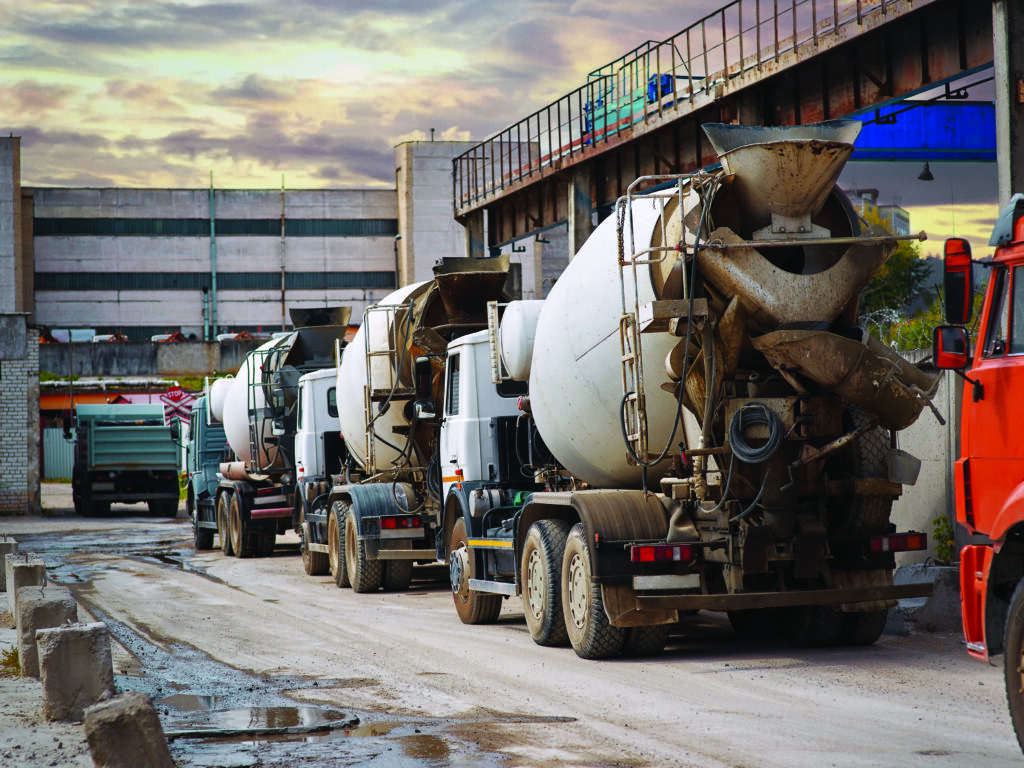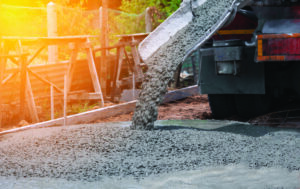
Concrete solutions
By ANDREW SNOOK
Concrete Green ConstructionFinding low-emission paths to concrete production.
When 196 parties signed on to The Paris Agreement at the end of 2015, the level of public and political attention given to greenhouse gas emission production spiked dramatically. With that commitment to limit global warming through the lowering of emissions, certain industries, including the concrete industry, were going to be impacted, and potentially pressured, far more than others to find sustainable solutions for their products—and sooner rather than later.
Fortunately for the sector, many companies, research organizations and governments around the world have been hard at work for many years to help make concrete production more sustainable.
“In Canada, we’re in a really interesting phase of the climate discussion,” says Adam Auer, president and CEO of the Cement Association of Canada. “So much of the climate discussion over the past number of years is really focused on carbon pricing as the primary instrument for decarbonization, both on the consumer side and on the industrial side. It feels like that sort of background policy is now well understood.”
But the path to decarbonization is more complicated than simply dollars on a ledger. And Auer says that the cement and concrete industry have been leaders in helping find solutions.
“If you understand the construction value chain, it’s quite complicated,” he explains. “If you want to decarbonize that chain, it’s not just about material manufacture, which is obviously a big component, but it’s also about codes and standards. It’s about the willingness of architects, developers and specifiers to accept innovation and try new things. It’s about the willingness for the market to pay more for really leading- edge stuff. It’s about thinking through things like material efficiency in the same way that we’ve thought through things like energy efficiency.”
He says that governments need to think more horizontally across their own portfolio about how the different levers they have on the policy side must work together to pave the way for industry to be able to make big investments in the technologies that are needed.
“In cement in particular, and I think it probably applies to a lot of other heavy manufacturing sectors, there’s really no silver bullet,” he says. “There’s a menu of technologies and policies, and they all come together to work.”
Some of these options, such as moving away from carbonized fuel supplies, are already happening, but the sector is still in the early stages, and some of the available technologies are expensive, making it difficult to build a business case to support their use without government incentives.
He says that government instruments like capital funding through the Net Zero Accelerator Initiative (NZA)—that’s the investment tax credit for carbon capture, utilization and storage—can help accelerate the pace of change.
“They’re talking about some really innovative instruments around carbon price certainty through things like carbon contracts,” he says, adding that programs like NZA help encourage the adoption of earlier stage, more capital-intensive technologies like carbon capture and storage.
There are some impressive technologies related to carbon utilization in cement and concrete that are currently being created.
Auer pointed to carbon capture technologies from companies like Carbon Upcycling Technologies and Blue Planet Systems as examples of how innovative aggregate and additives can be part of the discussion.
“There’s a huge opportunity to use concrete as a vehicle to sequester carbon,” he says, adding that other technologies are also under development, and in need of support. “It’s about making sure that when we look at the suite of options that are available for decarbonization, that we’ve gotten the right kind of policy, and support for each of those different stages.”
Of course, there’s no sense in waiting, since even a small step is a step in the right direction. As Auer says, “Let’s not wait for the silver bullets, like carbon capture utilization. Yes, we’re investing in those things. But in the interim, there’s a lot of things we can do today.”
HIGHER STANDARDS
One of the tools now available in the war on greenhouse gas emissions is the CarbonStar standard.
 Initially developed for Canada and the U.S., this standard offers governments and companies “a rigorous, transparent way to quantify, specify, and then reduce the carbon intensity of concrete based on a standard simple way to measure, report and specific CO2 intensity,” according to Decarbonising our Built Environment, Concrete Block by Concrete Block, written by Greg Kats of Smart Surfaces and the World Cement Association’s Ian Riley and Manon Burbidge.
Initially developed for Canada and the U.S., this standard offers governments and companies “a rigorous, transparent way to quantify, specify, and then reduce the carbon intensity of concrete based on a standard simple way to measure, report and specific CO2 intensity,” according to Decarbonising our Built Environment, Concrete Block by Concrete Block, written by Greg Kats of Smart Surfaces and the World Cement Association’s Ian Riley and Manon Burbidge.
The calculations used in the Carbon- Star standard are designed to account for the emitted and sequestered carbon per unit of concrete. It was created to limit global warming to 1.5º by 2050.
The first implementation of the CarbonStar standard is underway at the San Francisco International Airport (SFO), which has adopted the standard to reduce the warming impact of the concrete it plans to use on its upcoming building and infrastructure projects.
The airport lists three levels of CO2 intensity in its specifications for concrete, using the CarbonStar rating system with the minimum requirement being no more than 200 pounds of CO2 per cubic yard (119 kg/m3), and ramping up to a best case of not more than negative-200 pounds per cubic yard — or 60 per cent below the current industry average.
To ensure that the standard is being met, the concrete manufacturer will also be required to provide an Environmental Product Declaration (EPD) for its concrete mix and to document the EPD so that the airport and other stakeholders can record the embedded carbon.
Riley, who is CEO of the World Cement Association, says that concrete suppliers are mainly using blends to lower the CO2in the concrete they are producing and supplying to meet requirements like those requested by the SFO.
“Concrete suppliers are reducing their CO2 footprints mainly by using blended cements instead of OPC [Ordinary Portland Cement], since these have lower carbon footprints and supplementary cementitious products such as slag, fly ash and natural pozzolans,” he says.
New technologies may include geopolymer concretes, mainly with slag (sometimes fly ash, red mud and other materials) and no cement; as well as synthetic aggregates made from sequestered CO2, such as those created by Blue Planet.
“Additionally, AI can be used to optimize the packing of the particles, reducing the amount of binder needed. However, these technologies are in limited usage,” Riley says.
BIOPRODUCT SOLUTIONS
One of the solutions to help make concrete production more sustainable may come from the forestry sector.
For the past five years, FPInnovations, a private not-for-profit organization that specializes in the creation of solutions in support of the Canadian forest sector’s global competitiveness, has been researching ways to introduce wood pulp fibres to improve concrete recipes.
“We see that there’s a lot of improvements when adding the fibres,” says Helen Lentzakis, manager of the Biomaterials Division at FPInnovations.
To date, only small amounts of fibres have been added to concrete mixes with a variety of different fibre types being used in the recipes. Some of the mixes include the additions of Thermomechanical Pulp (TMP) fibres, Bleached Chemi-ThermoMechanical Pulp (BCTMP) fibres, softwood, and North Bleached Softwood Kraft (NBSK) fibres, as well as Crystalline Nanocellulose (CNC) and Cellulose Filaments (CF). With each mix, Lentzakis says her team has discovered different types of improvements.
“The major improvement is during the curing process to control cracking behaviours. By adding these fibres, we can control the amount that the shrinkage occurs, and ultimately, the cracking,” she explains. “What happens, especially with high-performance fibres for high-performance concrete, is that you don’t have a large amount of water, which increases the shrinkage.”
If the porous network of the concrete doesn’t have enough free water, the cellulose fibres release water to the concrete. “This is how you’re reducing the shrinkage, and ultimately, the cracking,” she says. “That’s an interesting property improvement that we’ve seen.”
FPInnovations’ Biomaterials Division has the capabilities to measure all the properties of the concrete from the fresh state to the hardened states. They test all the fresh properties including rheology properties, isothermal calorimetry, and most of the mechanical properties as well, including the flexural strength and the tensile strength as well as major concrete durability indicators. So, what are the benefits of adding these various fibres?
“The benefit is to increase the durability, especially the freeze-thaw resistance, which obviously is an important property in Canada,” says Lentzakis. “We test freeze-thaw cycles, and we see that there’s an improvement with the addition of the fibres.”
FPInnovations has not yet fully assessed the CO2 impact because they are working with such small amounts of fibres, but the benefit of increased durability in concretes certainly makes for an argument for more sustainable concrete production. Also, cellulose filaments (CF) make it possible to use local, lower quality sand sources without compromising performance.
“Because you’re improving the mechanical properties, such as a structural toughness, the advantage would be to use less concrete,” Lentzakis says. “Concrete is usually classified by compressive strength, so if you can increase the classification and have less concrete, and replace some concrete with fibres, you can have a significant impact.”
FPInnovations has also found that the use of these fibres in the concrete have helped with preventing corrosion in reinforced concrete.
“We did corrosion activity monitoring on outdoor reinforced concrete elements by applying chloride, and we saw that the fibres helped with retarding the corrosion that’s usually caused by chloride,” says Lentzakis. “We managed to have the 26 elements with different types of fibres of TMP, CNC, CF, BCTMP and NBSK fibres at different loading, and we saw with the improvement in corrosion there was a difference between how much fibre we are using. So, when you use too much fibre, you don’t see improvement in corrosion mitigation, but when you use less fibres, you see that improvement in corrosion, so that’s pretty interesting as well.”
BARRIERS TO IMPROVEMENT
While there are new technologies and products available and coming to market, one of the biggest roadblocks to the implementation of modified concrete products is human in nature. It can be difficult to convince engineers to change their specifications in a project away from long proven building materials. The same can be said for codes and standards as well.
While the industry has the ability to provide products and solutions with a lower embodied carbon, these products are sometimes at odds with traditional or boilerplate specs and, in some of these cases, these newer designs go against what has “always been done,” which is why there is a need for alignment across all players in the construction value chain to achieve more sustainable outcomes.
“Well-intentioned policies may run up against practices that are built on years of experience, and rightfully so,” says Ian Paine, director of Ready Mix Performance, Western Canada, at Lafarge Canada. “We greatly appreciate that the people responsible for our infrastructure are exceedingly conservative.”
As he says, the performance of the concrete material in a building or structure will always be the primary concern driving the material selection process, but once the appropriate level of performance for a mix has been demonstrated, there needs to be an ability to work these newer products into the specifications stream.
While engineers may see increased risk, companies like Lafarge have thoroughly tested their newer mixes and designs and stand by the performance of these materials in the same manner as they do with their traditional mixes. “While we fully appreciate the responsibilities of the stakeholders around the table, we are also very open to agreeing to an innovation process,” he says.
Even where there is a pathway for innovative products to be specified, a major challenge is the need to prove processes in multiple jurisdictions, duplicating efforts. Even when one jurisdiction in Canada approves a particular process or product, it can take several years for other jurisdictions to adopt it.
“We find that we have to repeat that process,” Paine says. “It takes extraordinary resources. That kind of time and manpower will require the industry. We strongly encourage that cross-knowledge transfer of experience.”
He’s hoping that industry associations can press for changes to that process, to make it less cumbersome for industry players.
“I would strongly encourage associations within the country to make sure that they’re using their platforms to talk about successes across geography,” he says. “So that maybe when someone in Ontario has agreed that a pilot was successful, then Alberta or Manitoba looks at that data and says, ‘That’s good enough for us.’”
Andrew Snook is a freelance writer and editor.






